
Fairlee is a town in Orange County, Vermont, United States. The population was 988 at the 2020 census. It includes the village of Ely. Fairlee is home to Lake Morey, which claims to have the longest ice skating trail in the United States.

Camping is a form of outdoor recreation or outdoor education involving overnight stays with a basic temporary shelter such as a tent. Camping can also include a recreational vehicle, sheltered cabins, a permanent tent, a shelter such as a bivy or tarp, or no shelter at all. Typically, participants leave developed areas to spend time outdoors, in pursuit of activities providing them enjoyment or in a form of educational experience. Spending the night away from home distinguishes camping from day-tripping, picnicking, and other outdoor activities.
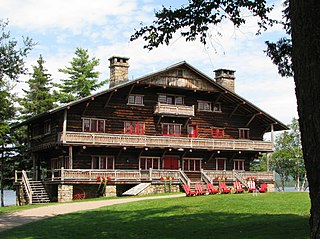
Great Camp Sagamore is one of several historic Great Camps located in the Adirondack Mountains of northern New York State.
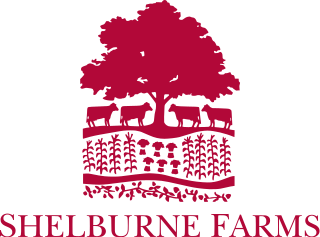
Shelburne Farms is a nonprofit education center for sustainability, 1,400-acre (570 ha) working farm, and National Historic Landmark on the shores of Lake Champlain in Shelburne, Vermont. The property is nationally significant as a well-preserved example of a Gilded Age "ornamental farm", developed in the late 19th century with architecture by Robert Henderson Robertson and landscaping by Frederick Law Olmsted.

Camp Billings is a co-ed, summer camp on Lake Fairlee in West Fairlee and Thetford, Vermont, United States. Accredited by the American Camp Association, it was established in 1906, and is open by boys and girls between the ages of eight and sixteen. In 2006, it was listed as a historic district on the National Register of Historic Places.

Camp Atwater is a summer camp on Shore Road in North Brookfield, Massachusetts. Originally named, St. John's Camp, it was established in 1921 by Dr. William N. DeBerry on the shores of Lake Lashaway. The camp gained the name "Atwater" when Mary Atwater donated $25,000 to Dr. DeBerry in 1926. They were funded to honor her late father who was Dr. David Fisher. Camp Atwater's mission was to provide a summer recreational experience for African-American boys, at a time when summer camps were generally racially segregated. The camp catered primarily to middle- and upper-class African Americans, and drew attendees from up and down the Atlantic coast. Notable attendees include Coleman Young, Clifford Alexander, Jr., Clifton Wharton, Jr., Hazel O'Leary, Dennis Hightower, and Wayne Budd. The camp was listed on the National Register of Historic Places in 1982. It is now owned and operated by the Urban League of Springfield.

The Scott Farm Historic District encompasses a historic farm property at 707 Kipling Road in Dummerston, Vermont. Developed between about 1850 and 1915, Scott Farm is a well-preserved farm and orchard complex of that period. It was listed on the National Register of Historic Places in 2001.

Bearnstow is a summer camp on Parker Pond in Mount Vernon, Maine. The camp offers weeklong and day programs for adults and children, with an emphasis on appreciation of nature through the arts and sciences. Founded in 1946, the camp occupies 65 acres (26 ha) on the east side of the pond, and is centered on the former Spruce Point Camps, whose facilities, built in the 1920s and 1930s, are listed on the National Register of Historic Places.
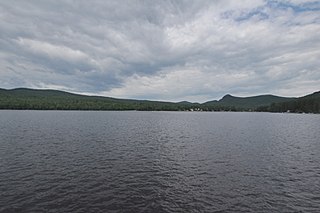
Stillwater State Park is a state park located on Lake Groton in Groton, Vermont. The park is located in Groton State Forest close to the Groton Nature Center, Boulder Beach State Park and Big Deer State Park. The park offers camping, picnicking, and access to water-related activities on Lake Groton. The park was developed in the 1930s by crews of the Civilian Conservation Corps (CCC). It is open to the public between Memorial Day weekend and Columbus Day weekend; fees are charged for day use and camping.

New Discovery State Park is a state park near Marshfield, Vermont in the United States. It is one of seven state parks located in Groton State Forest. The park is on Vermont Route 232, offering camping, picnicking, and access to forest trails. The park was developed in the 1930s by the Civilian Conservation Corps; its major CCC-built facilities, located mainly in western Peacham, were listed on the National Register of Historic Places in 2002.
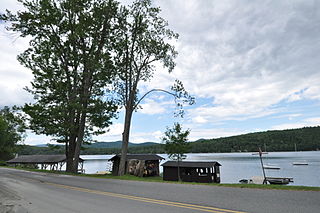
Aloha Camp is a summer camp for girls on Lake Morey in Fairlee, Vermont. Founded in 1905, it is the oldest girls' camp in the state. Open to children aged 12 to 17, it offers outdoor activities, arts and nature programs, and wilderness camping opportunities. The camp season is divided into two sessions of 3-1/2 weeks, running from late June to mid-August. The camp property is listed on the National Register of Historic Places.

Aloha Hive Camp is a summer camp for girls on Lake Fairlee in West Fairlee, Vermont. Founded in 1915 as an expansion of Aloha Camp, it is open to girls aged 7 to 12, with two sessions between mid-June and late August. The camp operates on more than 400 acres (160 ha), offering a variety of outdoor activities as well as a rich arts and crafts program. The camp facilities were listed on the National Register of Historic Places in 2003.
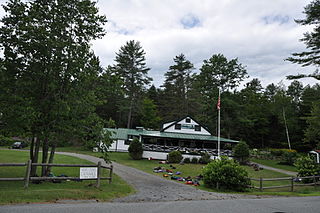
Aloha Horizons Camp is a summer camp for boys and girls on Lake Fairlee in West Fairlee, Vermont. Opened in 1921 as Camp Wyoda, its property was acquired by the Aloha Foundation in 1997, and is now operated by that organization as a day camp for local children and vacationers staying in the area. Camp is divided into three two-week sessions; activities include water sports, land sports, and arts and crafts. The camp property, organized around a former farmstead, was listed on the National Register of Historic Places in 2003 for its well-kept collection of surviving early camp architecture.
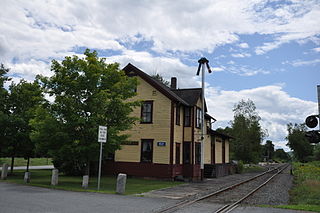
The Ely Railroad Depot is a historic railroad station at Ely Road and Old Route 5 in Fairlee, Vermont. Built in 1900 by the Boston and Maine Railroad, it is a well-preserved rural station, designed to house the stationmaster as well as providing station facilities. It was listed on the National Register of Historic Places in 1994.

Fairlee Town Hall, at 75 Town Common Road, is the municipal heart of Fairlee, Vermont. It was built in 1913 to a design by a local architect, replacing the old Fairlee Opera House, which was destroyed by fire in 1912. It is a fine example of Colonial Revival architecture, and is a focal point of the village center and the town's civic life. It was listed on the National Register of Historic Places in 2014.

The Asa May House is a historic farmstead on Blood Brook Road in West Fairlee, Vermont. Developed in the late 18th century, the c.1800 house is a rare statewide example of Federal period architecture, built for West Fairlee's first town clerk. The farmstead property, including a barn, sheds, and period landscape elements, was listed on the National Register of Historic Places in 1993.

Field Farm is a historic farm property on Fuller Mountain Road in Ferrisburgh, Vermont. Developed around the turn of the 19th century, the property includes an early farmhouse and barn, as well as outbuildings representative of Vermont's trends in agriculture over two centuries. The property was listed on the National Register of Historic Places in 1995.
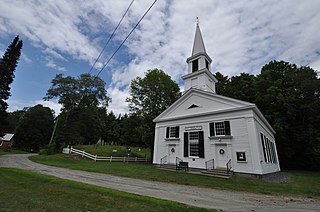
The West Fairlee Center Church is a historic church building at Middlebrook and Bear Notch Roads in West Fairlee, Vermont. Built in 1855, it is a fine and little-altered example of rural Greek Revival architecture, also notable for the association of its congregation with Nathaniel Niles, a prominent local minister, landowner, and politician. It was listed on the National Register of Historic Places in 2002.
The Proctor Maple Research Center is an agricultural research center of the University of Vermont specializing in the study of sugar maples, particularly with respect to the production of sap for use in maple syrup. It is the only facility of this type in the United States. Its facilities are located on Harvey Road in Underhill, Vermont, on a rural property previously known as the Harvey Farm, given to the state in 1946 by Governor of Vermont Mortimer Proctor. The center's early facilities and century-old sugar bush are listed on the National Register of Historic Places.
Camp Marbury was a summer camp for girls on Lake Champlain in Ferrisburgh, Vermont. Founded in 1921, the family-run camp operated until 1942, when it closed due to logistical difficulties associated with World War II. The camp property is listed on the National Register of Historic Places.





















